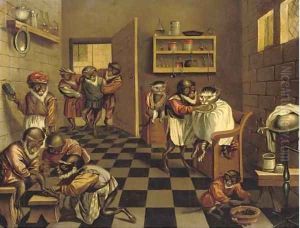Jan Van Kessel II Paintings
Jan van Kessel II was a Flemish painter born into an illustrious family of artists in Antwerp in 1654, a city then thriving as a cultural and economic hub within the Spanish Netherlands. His grandfather, Jan Brueghel the Elder, and his father, Jan van Kessel the Elder, were both renowned painters, which positioned him within a lineage that had significantly shaped the Flemish artistic landscape. This heritage provided him with an environment rich in artistic tradition and an extensive network of contacts in the art world from an early age. Despite the overshadowing fame of his predecessors, Jan van Kessel II carved out his own niche, primarily focusing on still life and genre scenes that reflected the era's fascination with detail, nature, and the exotic.
Van Kessel II's training likely commenced in his father's workshop, a common practice for artistic dynasties of the time. By 1677, he became a master in the Guild of St. Luke in Antwerp, marking his formal acceptance as a professional artist. His works demonstrate a meticulous attention to detail and a vibrant palette that was characteristic of Flemish painting of the period. He excelled in creating compositions that combined elements of still life with scenes of everyday life, often imbued with allegorical meaning. His paintings often featured flowers, insects, and small animals, painted with scientific accuracy but arranged within imaginative and often whimsical settings.
Throughout his career, Van Kessel II remained in Antwerp, where he contributed to the city's artistic legacy. His works were sought after by collectors and connoisseurs, not only in the Spanish Netherlands but also across Europe, indicating the widespread appeal of his detailed and delicate compositions. Despite his success, Jan van Kessel II did not achieve the same level of fame as some of his ancestors or contemporaries. However, his artwork provides a valuable insight into the late 17th-century Flemish artistic milieu, showcasing the era's intricate craftsmanship and the enduring fascination with the natural world.
Jan van Kessel II died in Antwerp in 1708. Today, his works are preserved in several major museums around the world, where they continue to be studied and admired for their beauty and intricate detail. Through his paintings, Van Kessel II contributes to the rich tapestry of Flemish art, bridging the legacy of his famous family with the evolving tastes and interests of the late 17th and early 18th centuries.
